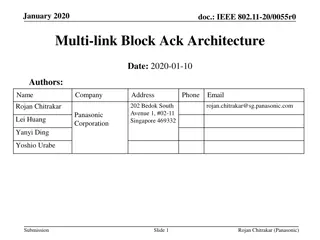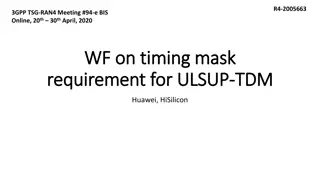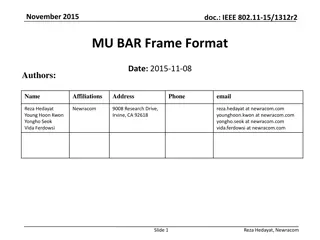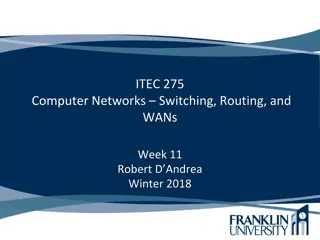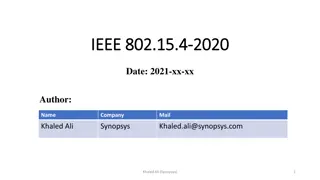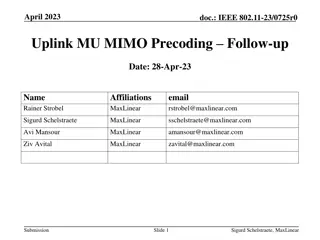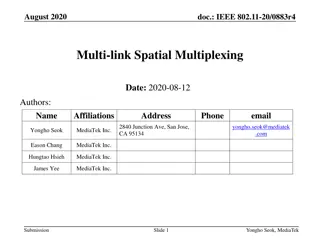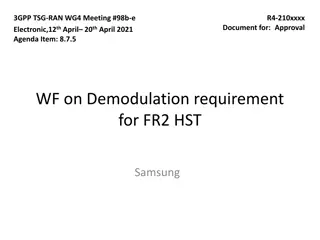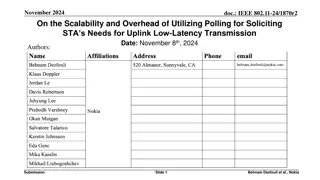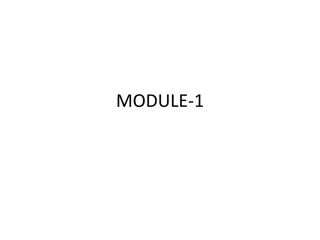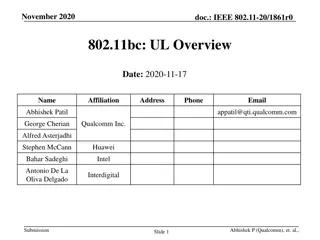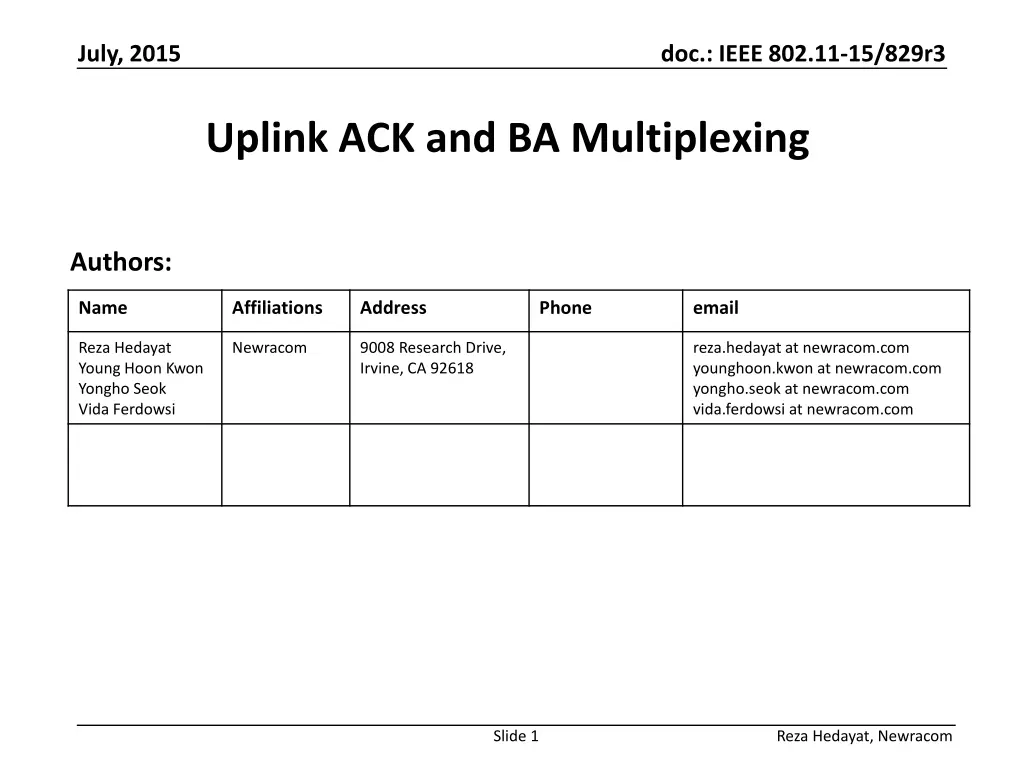
IEEE 802.11-15 Uplink ACK and BA Multiplexing Details
"Learn about the mechanism for multiplexing ACK/BA frames in response to DL MU transmission in IEEE 802.11-15 standards. Details include attributes, frame contents, and PHY/MAC considerations for UL OFDMA frames."
Download Presentation

Please find below an Image/Link to download the presentation.
The content on the website is provided AS IS for your information and personal use only. It may not be sold, licensed, or shared on other websites without obtaining consent from the author. If you encounter any issues during the download, it is possible that the publisher has removed the file from their server.
You are allowed to download the files provided on this website for personal or commercial use, subject to the condition that they are used lawfully. All files are the property of their respective owners.
The content on the website is provided AS IS for your information and personal use only. It may not be sold, licensed, or shared on other websites without obtaining consent from the author.
E N D
Presentation Transcript
July, 2015 doc.: IEEE 802.11-15/829r3 Uplink ACK and BA Multiplexing Authors: Name Affiliations Address Phone email Reza Hedayat Young Hoon Kwon Yongho Seok Vida Ferdowsi Newracom 9008 Research Drive, Irvine, CA 92618 reza.hedayat at newracom.com younghoon.kwon at newracom.com yongho.seok at newracom.com vida.ferdowsi at newracom.com Slide 1 Reza Hedayat, Newracom
July, 2015 doc.: IEEE 802.11-15/829r3 Background TGax adopted DL OFDMA, and with DL MU MIMO there are now two DL MU mechanisms The efficiency of DL OFDMA is enhanced significantly if multiple ACK/BAs are multiplexed in response to a DL OFDMA PPDU 11ax SFD: The amendment shall include a mechanism to multiplex BA/ACK responses to DL MU transmission. In this contribution some details on how ACK/BA frames could be multiplexed in response to a DL MU are presented Slide 2 Reza Hedayat, Newracom
July, 2015 doc.: IEEE 802.11-15/829r3 ACK/BA Frame Attributes in Legacy Designs Content of L-SIG, SIG-A and SIG-B In legacy amendments, these fields are decided by each STA as specified by the spec ACK/BA frame size ACK: 14B Compressed BA: 32B Multi-TID BA: 22B + 12B per each TID MCS and NSS Under current rules and designs MCS and NSS are selected by the STA Guard Interval (GI) Under current rules and designs GI is selected by the STA: 0.8us or 0.4us Slide 3 Reza Hedayat, Newracom
July, 2015 doc.: IEEE 802.11-15/829r3 MU ACK: UL ACK/BA Multiplexing PHY/MAC attributes of each ACK/BA frame in an UL OFDMA frame Content of L-SIG and HE SIG Need to be set by all STAs with the same values MCS and NSS Could be decided by each STA as currently done, or AP could require all STAs to use a robust MCS and NSS choices GI, LTF compression, AP need to mandate that all STAs use the same values for these parameters Sub-band assignment Assignments for the sub-bands of each ACK/BA frame need to be given by the AP (next slides) Slide 4 Reza Hedayat, Newracom
July, 2015 doc.: IEEE 802.11-15/829r3 Contents of L-SIG and HE SIG Content of L-SIG STAs shall set the Length field of the L-SIG with a duration value that is indicated or calculated based on a TBD field of the preceding DL MU PPDU. The RATE field in the L-SIG field in an HE MU PPDU is set to the value representing 6 Mb/s. Content of HE SIG Currently the content of SIG-A is not decided All the STAs shall set the content of TBD fields of the HE SIG-A of an UL MU PPDU with the same fields of the SIG-A of the preceding DL MU PPDU, and some other TBD fields might be set with pre-defined or reserved values Slide 5 Reza Hedayat, Newracom
July, 2015 doc.: IEEE 802.11-15/829r3 Selection of MCS and NSS MCS selection Currently a STA selects its MCS for ACK/BA frame independently But if there is no HE SIG-B/C in UL MU, the MCS selection need to be settled before transmission of MU ACK frame AP needs to signal MCS for each ACK/BA separately, or a given MCS for all ACK/BAs at once Alternatively, if SIG-C exists the STA can indicate the MCS in SIG-C NSS selection Currently a STA can select NSS>1 for ACK/BA frame, though not beneficial throughput-wise However in MU ACK, the presence of NSS>1 complicates the UL MU frame unnecessarily One choice is to disallow MU ACK with NSS>1 Alternatively if SIG-C is present, the AP can indicate an NSS>1 in the Trigger frame or the preceding DL MU frame, after which the STAs would have appropriate number of LTF symbols and indicate their NSS Slide 6 Reza Hedayat, Newracom
July, 2015 doc.: IEEE 802.11-15/829r3 Other Parameters that all STAs follow GI, LTF compression, These set of parameters need to be set by all STAs to the same values, otherwise MU ACK frame cannot be decoded correctly Selection of some of these parameters, such as GI, are environment-dependent, hence it d be good to let AP set these values So an option is that the AP sets these values specifically in the Trigger frame or the preceding DL MU frame, or the STAs use the same GI and LTF compression values from the preceding DL MU frame Slide 7 Reza Hedayat, Newracom
July, 2015 doc.: IEEE 802.11-15/829r3 Sub-band Assignment for ACK/BA Multiplexing Explicit sub-band assignment In each DL OFDMA PPDU, AP can explicitly indicate what sub-band to be used by the STA for placing the ACK/BA If the ACK Policy subfield of QoS Control is set to No ACK , then the AP does not assign any sub- band to the STA Explicit assignment allows the AP to assign best/better sub-bands for each STA Implicit sub-band assignment STAs might pick up a sub-band (from the set of the sub-bands) based on some order that avoids two STAs selecting the same sub-band For instance, based on the same order that their DL assignment appears in the preceding DL OFDMA PPDU, or the same order as in the GID of the preceding DL MU MIMO PPDU For this case, the bandwidth of sub-bands used for ACK/BA need to be known to STAs e.g. be pre- announced in the preceding DL OFDMA frame etc Slide 8 Reza Hedayat, Newracom
July, 2015 doc.: IEEE 802.11-15/829r3 Options for ACK/BA Sub-band Assignment Using same sub-band as DL payload One option is to let each STA use the same sub-band(s) as its DL payload, e.g. a STA that has a 2MHz sub-band uses the same 2MHz sub-band for UL, and a STA that has an 8MHz sub-band uses the same 8MHz sub-band. However, the bandwidth required for ACK/BA frames are mostly different with the bandwidth used for DL payload. Hence, the variance of sub-bands bandwidth assigned to DL payloads is larger than that of ACK/BA STA1 STA2 STA1 ACK/BA STA2 ACK/BA L-STF/LTF/SIG, HE SIG L-STF/LTF/SIG, SIG-A HE SIG-B HE STF/LTF STA3 ACK/BA STA3 IFS STA4 STA4 ACK/BA Slide 9 Reza Hedayat, Newracom
July, 2015 doc.: IEEE 802.11-15/829r3 Options for ACK/BA Sub-band Assignment Using same sub-band as DL payload Using 2MHz and 4MHz sub-bands for ACK/BA frames requires: For 2 MHz sub-band, ACK payload size is 10/5/4/3/2/ symbols for MCS0-9 For 4 MHz sub-band, ACK payload is 5/3/2/2/1/ symbols for MCS0-9 For 2 MHz sub-band, BA payload size is 22/11/8/6/4/3/3/3 symbols for MCS0-9 For 4 MHz sub-band, BA payload size is 11/6/4/3/2/2/2 symbols for MCS0-9 Using same sub-bands as in the DL OFDMA frame could cause some ACK/BA frames to takes several symbols while other ACK/BA frames to pad excessively STA1 STA2 STA1 ACK/BA STA2 ACK/BA L-STF/LTF/SIG, HE SIG L-STF/LTF/SIG, SIG-A HE SIG-B HE STF/LTF STA3 ACK/BA STA3 IFS STA4 STA4 ACK/BA Slide 10 Reza Hedayat, Newracom
July, 2015 doc.: IEEE 802.11-15/829r3 Options for ACK/BA Sub-band Assignment Implicit indication Sub-bands of 2MHz, 4MHz, or 8MHz are chosen by the AP for ACK and BA frames and indicates the unit BW of ACK/BA sub-bands in SIG-B of the DL PPDU Sub-bands are assigned to STAs implicitly; each STA picks the sub-band that has the same order as its assignment in DL OFDMA Pros and cons: As long as DL PPDU/SIG-B is received correctly the UL sub-band assignment is known to the STAs AP has limited role in UL sub-band assignment hence more likelihood of lengthier multiplexed ACK/BA response Some STAs might have their sub-band for ACK/BA frame in deep fade SIG-B shows the DL assignments in this order:STA1, STA2, STA3, STA4 Unit BW of ACK/BA frames indicated in SIG-B Each STA picks the sub-band with the indicated BW and same order as its DL assignment STA1 ACK/BA Example: PPDU BW = 20MHz ACK/BA BW = 4MHz STA1 STA2 L-STF/LTF/SIG, HE SIG L-STF/LTF/SIG, SIG-A STA2 ACK/BA HE SIG-B HE STF/LTF IFS STA3 STA3 ACK/BA STA4 STA4 ACK/BA Slide 11 Reza Hedayat, Newracom
July, 2015 doc.: IEEE 802.11-15/829r3 Options for ACK/BA Sub-band Assignment Explicit indication in SIG-B AP indicates the index of each ACK/BA sub-band in SIG-B of the DL PPDU Unlike implicit assignment, AP can assign sub-bands with possibly varying bandwidth to ACK and BA depending on what it expects Pros and cons: As long as DL PPDU/SIG-B is received correctly the UL assignment is known to the STAs It requires multiple exchanges within MAC and PHY entities: AP-MAC indicates the assigned sub- bands to AP-PHY, then STA-PHY passes the parameter to STA-MAC, and finally STA-MAC let the STA-PHY know what sub-band to use for placing the ACK/BA. In SIG-B, each DL assignment has a sub-band assignment for ACK/BA Each STA picks the assigned sub-band STA1 STA2 STA4 ACK L-STF/LTF/SIG, HE SIG L-STF/LTF/SIG, SIG-A STA2 BA HE SIG-B HE STF/LTF IFS STA3 STA1 BA STA4 STA3 ACK Slide 12 Reza Hedayat, Newracom
July, 2015 doc.: IEEE 802.11-15/829r3 Options for ACK/BA Sub-band Assignment Explicit indication in MAC Header AP indicates the index of each ACK/BA sub-band in the MAC header of the MPDUs in DL OFDMA assignment, as long as the ACK policy is set to Normal ACK or Implicit BAR Pros and cons: As long as one MPDU is received correctly the UL assignment is known to the STA The added field in MAC header appears in all MPDUs and could be high overhead in large AMPDUs In MAC header, sub-band assignment for ACK/BA frames are indicated Each STA picks the assigned sub-band STA1 STA2 STA4 ACK L-STF/LTF/SIG, HE SIG L-STF/LTF/SIG, SIG-A STA2 BA HE SIG-B HE STF/LTF IFS STA3 STA1 BA STA4 STA3 ACK Slide 13 Reza Hedayat, Newracom
July, 2015 doc.: IEEE 802.11-15/829r3 Options for ACK/BA Sub-band Assignment Explicit indication in a Trigger Frame AP adds a Trigger frame to each DL assignment, preferably as the first MPDU The Trigger MPDU indicates the index of the sub-band and other necessary information for the expected ACK/BA Pros and cons: More aligned with the role of Trigger frame If the Trigger frame is lost the opportunity to send ACK/BA is lost, hence the DL payload has to be retransmitted For each DL payload there is a single-STA Trigger frame (shown in grey) Each STA forms its ACK/BA fame according to the Trigger frame within its DL payload STA1 STA2 STA4 ACK L-STF/LTF/SIG, HE SIG L-STF/LTF/SIG, SIG-A STA2 BA HE SIG-B HE STF/LTF IFS STA3 STA1 BA STA4 STA3 ACK Slide 14 Reza Hedayat, Newracom
July, 2015 doc.: IEEE 802.11-15/829r3 Options for ACK/BA Sub-band Assignment Trigger Frame/MU BAR AP sets the ACK policy for all the MPDUs in a DL MU frame to Block ACK, hence all the STAs wait for a BAR. Then AP sends a Trigger frame and specifics sub-band assignment Pros and cons: More aligned with the Trigger frame concept and role Additional overhead due to appearance of a separate Trigger/BAR frame STA1 STA2 STA4 BA Trigger Frame, MU BAR L-STF/LTF/SIG, HE SIG L-STF/LTF/SIG, SIG-A STA2 BA HE SIG-B HE STF/LTF IFS IFS STA3 STA1 BA STA4 STA3 BA Slide 15 Reza Hedayat, Newracom
July, 2015 doc.: IEEE 802.11-15/829r3 Comparison of ACK/BA Sub-band Assignment Options Indication Overhead (per DL MU PPDU) Low, ~1 Byte Low, ~1-2 Bytes per STA High, ~1-2 Bytes per STA, per MPDU Medium, >16 Bytes per STA5 Efficiency of right- sizing ACK/response frames Low1 Good Robustness Implicit indication Explicit indication in SIG-B Explicit indication in MAC header Explicit indication in Trigger frame Robust2 Robust2 Good Robust3 Good Less robust4 1. 2. More likelihood of lengthier ACK/BA frames than others It s robust since as long as the SIG-B field of the preceding DL MU PPDU is decoded correctly, the STAs know the UL sub-band assignment It s robust since as long as one MPDU in a DL payload of the preceding DL MU PPDU is decoded correctly, the STAs know the UL sub-band assignment Less robust, in case of erroneous Trigger frame FC(2B)+Duration(2B)+A2(6B)+Common Info(TBD)+Per User Info(TBD)+FCS(4B) 3. 4. 5. Slide 16 Reza Hedayat, Newracom
July, 2015 doc.: IEEE 802.11-15/829r3 Conclusion Some of the details UL ACK/BA multiplexing that should be provided by the AP are: sub-band assignment, and the duration Sub-band assignment in an UL MU frame that carries multiplexed ACK/BA could be done in multiple ways among which are: Implicit indication using the HE SIG-B of the preceding DL MU frame Explicit indication in the HE SIG-B of the preceding DL MU frame Indication in MAC header Addition of a Trigger MPDU to each DL payload The tradeoffs among above methods are robustness, overhead, and complexity Slide 17 Reza Hedayat, Newracom
July, 2015 doc.: IEEE 802.11-15/829r3 Strawpoll Do you agree to add the following to 11ax SFD: 4.x Multi-user (MU) features The HE SIG-B of a DL MU PPDU may carry an indication of the frame length of the response ACK/BA frames, and may carry the information that enables sub- band assignment for the response ACK/BA frames. Slide 18 Reza Hedayat, Newracom
July, 2015 doc.: IEEE 802.11-15/829r3 Strawpoll Do you agree to add the following to 11ax SFD: 4.x Multi-user (MU) features In each payload within a DL MU PPDU a Trigger frame may be present that carries the information that enables the recipient of the STA to send its ACK/BA response frame after a TBD IFS after the DL MU PPDU Slide 19 Reza Hedayat, Newracom
July, 2015 doc.: IEEE 802.11-15/829r3 Strawpoll Do you agree to add the following to 11ax SFD: 4.x Multi-user (MU) features An HE STA that responds with an UL MU PPDU to a DL MU PPDU or Trigger frame shall set the GI of the UL MU PPDU to the same GI value as the preceding frame, and shall set the HE-LTF symbol duration of the UL MU PPDU to the same HE-LTF symbol duration as the preceding frame. Slide 20 Reza Hedayat, Newracom
July, 2015 doc.: IEEE 802.11-15/829r3 Appendix: OFDMA Numerology Number of tones in each sub-band 2 MHz: 26-tone with 2 pilots 4 MHz: 52-tone with 4 pilots 8 MHz: 106-tone with 4 pilots 16 MHz: 242-tone with 8 pilots Slide 21 Reza Hedayat, Newracom

